I want you to begin the school year with a personal narrative, specifically these strategies for finding authentic topics for a personal narrative. Why? Well, to begin with, the personal narrative is autobiographical, and students like writing (and talking) about themselves. But that’s not all. You’ll also notice that these prewriting strategies will engage them immediately while simultaneously building community and developing writing skills.
Depending on how much time you have for prewriting, choose three to five of the following activities to help students generate ideas for personal narrative essays. Then have them choose one draft to take through the writing process.
As always, you can do it yourself or visit my store for the products I discuss. (My handouts will save you class time, but both ways work!)
Find Topics for a Personal Narrative with Kinder Memories
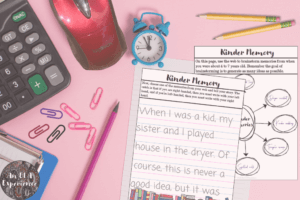
This is one of my favorite activities for discovering personal narrative writing ideas mainly because of the student engagement, although it has produced some entertaining stories (like the one a seventh grader wrote about waking up to a little girl kissing him during nap time. He had the class roaring!)
Supplies
Each student will need
- a pen,
- a blank sheet of paper,
- and a page or two of primary-level writing paper.
How to
Students begin by writing kinder memory in the middle of the web. They then brainstorm memories from when they were little, around three to seven years old. (Students can list memories from any young age in or out of the classroom.)
Next, comes the part that will have students groaning, laughing, and engaged. Pull out the primary-level paper, and ask them to write about one of their memories with the hand they don’t normally write with. This will make their handwriting look like a kindergartener’s, and this is what makes them love this activity. It’s something different; no teacher has asked them to do this before! (Of course, if this is too torturous, allow them to switch hands after a few lines of writing.)
Allow students to read their narratives to a partner and/or to the class.
Discover Topics for a Personal Narrative by Brainstorming on a Chart
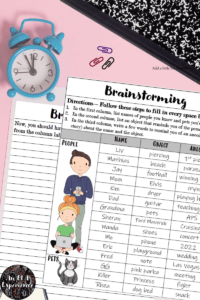
This activity is another one of my favorites but for a different reason: It helps students zoom in on specific moments. They’re not writing a book. They are writing a one to two-page narrative (although I do allow students to turn in up to ten pages). Since this is a short narrative, we want students to focus on a small amount of time, not an entire weekend, and this activity allows them to do that.
Supplies
Each student will need
- a pen,
- a sheet of paper/handout,
- and a ruler (if doing it yourself).
How to
If you’re DIYing, have students draw two vertical lines across their papers so they end up with three columns of equal width. Write names, objects/nouns, and anecdotes/stories at the top of each column respectively.
Now it’s time to start brainstorming. Work on one column at a time, modeling for students and then allowing them a few minutes to brainstorm.
Begin by listing people who are important to you in the first column. Next, list animals you love or loved.
Now move to the second column and note an object that reminds you of each person and pet.
For the third column, write a few words to remind you of an anecdote about the name and object.
Now, students have fifteen personal narratives to choose from. Ask them to select one, write about it, and include all the details they can remember.
Allow students to read their narratives to a partner and/or to the class.
Uncover Topics for a Personal Narrative by Listing with These Prompts
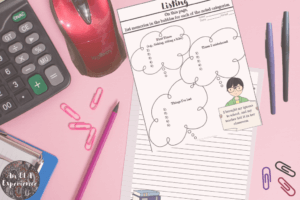
I usually use this activity for students who have been absent and fallen behind because it’s a quick way to come up with interesting ideas for personal narrative essays. However, it also comes in handy when you’re pressed for time.
Supplies
Each student will need
- a pen or pencil
- and a sheet of paper.
How to
Model the following for students:
Draw three cloud bubbles, and label them First Times, Times I Misbehaved, and Things I’ve Lost.
In the first bubble, First Times, brainstorm memories about the first time you did something (e.g., kissing, fishing, deer hunting).
In the second bubble, list memories of times you misbehaved (e.g., cheated, skipped school, told a fib). (One of my students wrote a fabulous story about convincing another student to bring her pet bunny to school in her backpack and then reporting her to their teacher. It was authentic, memorable, and beautifully written.)
In the third column, note things you’ve lost (e.g., a shoe, a book, a game, a loved one, money, innocence, freedom).
When you’ve finished your brainstorming, choose one story to tell and start writing.
Allow students to read their narratives to a partner and/or to the class.
Come up with Topics for a Personal Narrative with a Pie-in-the-Face Activity
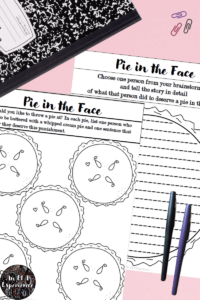
This prewriting activity asks students to write about who they’d like to throw a pie at, and their voices will shine!
Supplies
Each student writer will need
- a pen or pencil
- and a sheet of paper.
The teacher will need
- access to YouTube
- and a screen to project the video onto.
How to
Begin by viewing and discussing a quick pie-in-the-face video to grab students’ attention.
Draw five pies or circles onto a sheet of paper.
In each pie, list one person who deserves to be battered with a whipped cream pie and write one sentence that notes why they deserve this punishment. You’ll now have five focused personal narrative topics!
Choose one person from your brainstorming and tell the story in detail of what that person did to deserve a pie in the face. Try ending your story with a lesson or a reflection on the moment. (Remind students not to write about their peers for this one.)
Allow students to read their narratives to a partner and/or to the class.
Explore Topics for a Personal Narrative with a Timeline
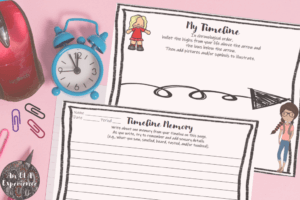
The timeline is a perfect activity for your visual learners and for finding significant moments in students’ lives because it asks them to note and illustrate important events from their lives in chronological order.
Supplies
Each writer will need
- a pen or pencil,
- a marker,
- and a sheet of paper.
How to
Place your paper in a landscape position (as seen in the above photo) and draw a horizontal line across the page.
In chronological order, bullet the highs from your life above the line and the lows below. Then add pictures or symbols to illustrate.
Next, write about one memory from your timeline. As you write, try to remember and add sensory details (e.g., what you saw, smelled, heard, tasted, and/or touched).
Allow students to read their narratives to a partner and/or to the class.
Bonus–Find Topics for a Personal Narrative with Blueprinting

I didn’t create a product for this activity because you don’t need one, but I’m including it because it’s an engaging lesson that produces plenty of topics for personal narratives. (Thank you to Joyce Armstrong Carroll and Edward E. Wilson for introducing me to this activity in their book Acts of Teaching.)
Supplies
Each student will need
- a pen or pencil
- and a sheet of paper. (Use colored 8 ½” x 11” sheets for students’ composition books; use larger sizes of construction paper for wall displays.)
The teacher will need
- access to YouTube
- and a screen to project the video onto.
How to
Start by watching Miranda Lambert’s “The House that Built Me.” A country-music-loving friend of mine shared this video idea with me, and it fits perfectly with this blueprinting activity. In the video, Miranda’s character visits the house she grew up in, and memories begin flooding in, and this is exactly what students will be doing with their writing.
Next, fold the paper into a house as seen in the video below. You’ll now have six sections to brainstorm in and one section to write in.
Think of a house that you’ve lived in for a while or one that you spend a lot of time in (e.g., a grandparent’s house). Then, in the brainstorming sections (on the doors of the house), note the rooms where the most memories come to mind. (You can use the backyard for a room; I don’t recommend using the bathroom.)
Visualize yourself returning to these areas and the memories that were made there, and list them in the corresponding rooms.
Finish up by selecting one memory to discuss, opening the doors to your house, and writing your story. After you finish writing, underline a compound sentence (or whatever sentence type you’re studying).
Allow students to read their personal narratives to a partner and/or to the class.
Personal Narrative Prewriting Tips for Students
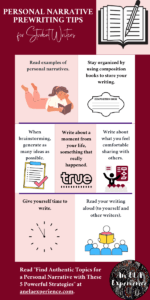
Tips for Teaching the Personal Narrative
- Read examples of personal narratives before students begin writing so they will have an example of what they will be writing. (“Fish Cheeks” is one of my favorites.)
- Use composition books as writers’ notebooks. Students can tape these prewriting pages into their books to refer to them easily. (In August, Walmart has these on sale for fifty cents each. I keep a few on hand for those students who forget to bring supplies.)
- Remind students that the purpose of brainstorming is to generate as many ideas as possible.
- Allow volunteers to read their brainstorming lists to the class. This will remind classmates of experiences they can add to their own lists.
- Remind students that personal narratives are non-fiction. They should be true stories, and by writing about events that they experienced, they will be able to include more details than they would if they were making things up.
- Also remind students to write about memories they feel comfortable sharing with others.
- Give them time to write. (For these prewriting activities, I give them around five to ten minutes for brainstorming, depending on the activity, and ten to fifteen minutes for first-draft writing.)
- Write with students. This will show them that you value writing and provide them with a great example.
- Model each step for students while projecting your writing onto the screen. They will understand better if you show them what you expect.
- Allow students to read their stories to a partner. This gives everyone an opportunity to share their story.
- Follow the partner readings with a whole-class volunteer share. (Unless someone is dying to read, I usually limit this to three students so we don’t spend the entire period on this step.)
- Read your draft to them too.
- Close each lesson with questions, exit slips, summaries of what they learned, or thumbs (up, down, or sideways based on how well they think they did).
Related Links
To move students into planning and drafting, visit blog #4, “Teach Students How to Write Personal Narratives with Graphic Organizers.”
For high school strategies, read “5 Ways to Spice Up Your Narrative Writing Unit for High School ELA.”
For a list of topics with quick directions, visit Suzanne Davis’s “13 Thought-Provoking Personal Narrative Prompts.”
I’d Love to Hear from You!
I know these prewriting activities will engage your students, but I would still love to hear about your experiences with them! Leave a comment to let me know about the engagement, community building, or topics for a personal narrative that your students discovered with these activities!


